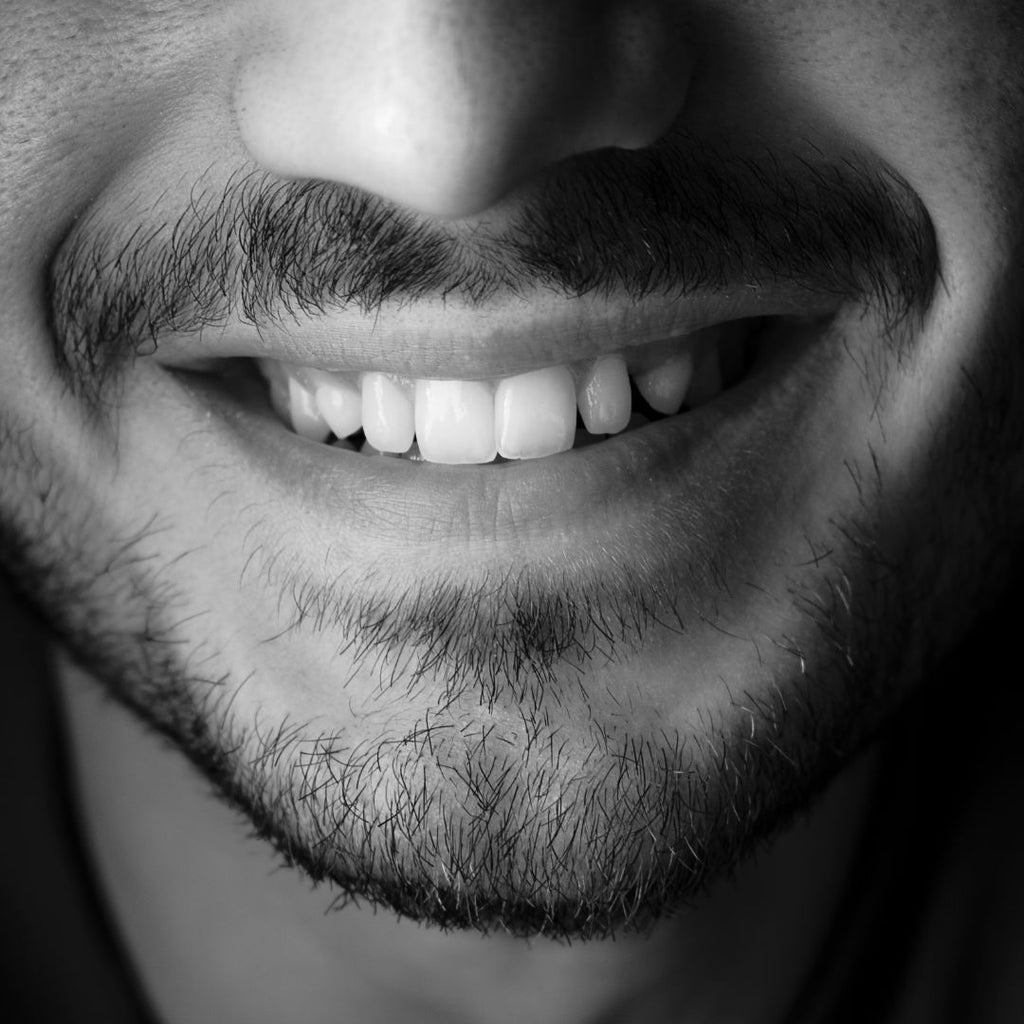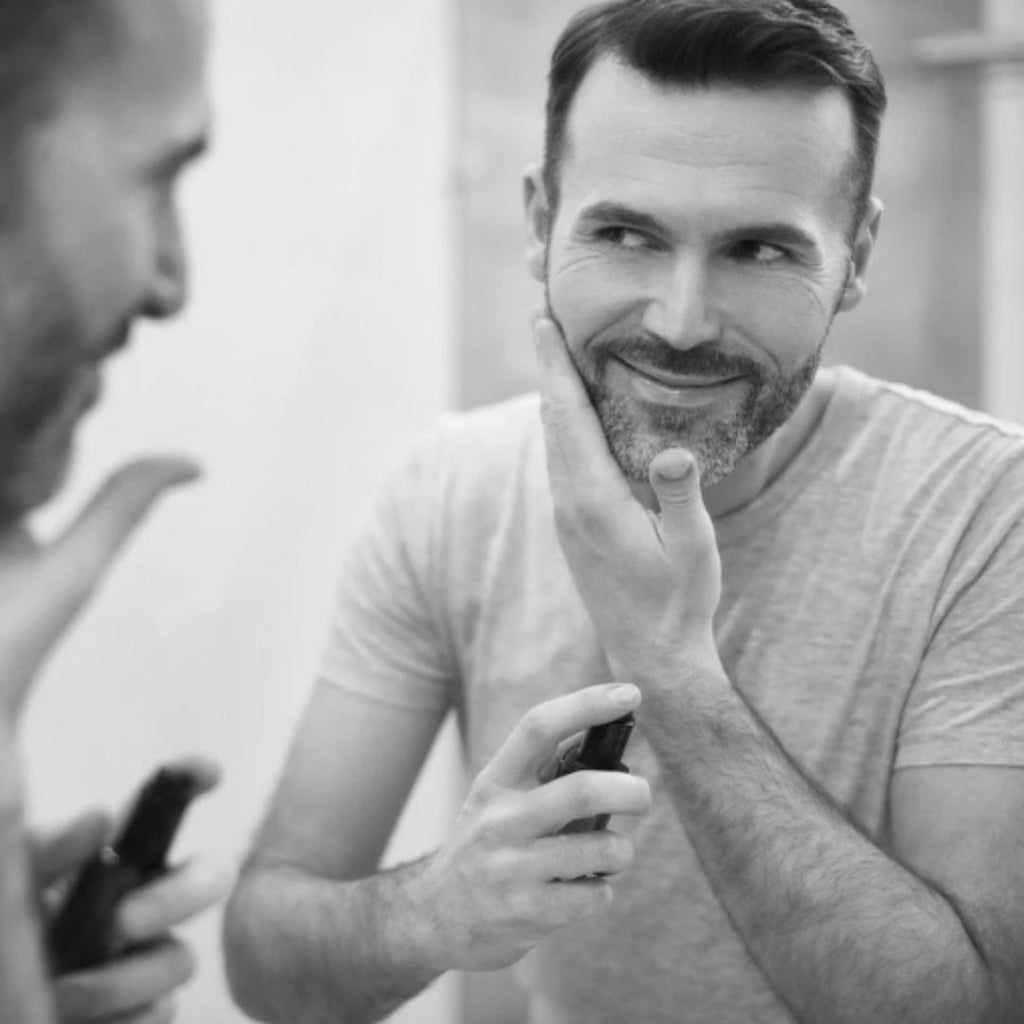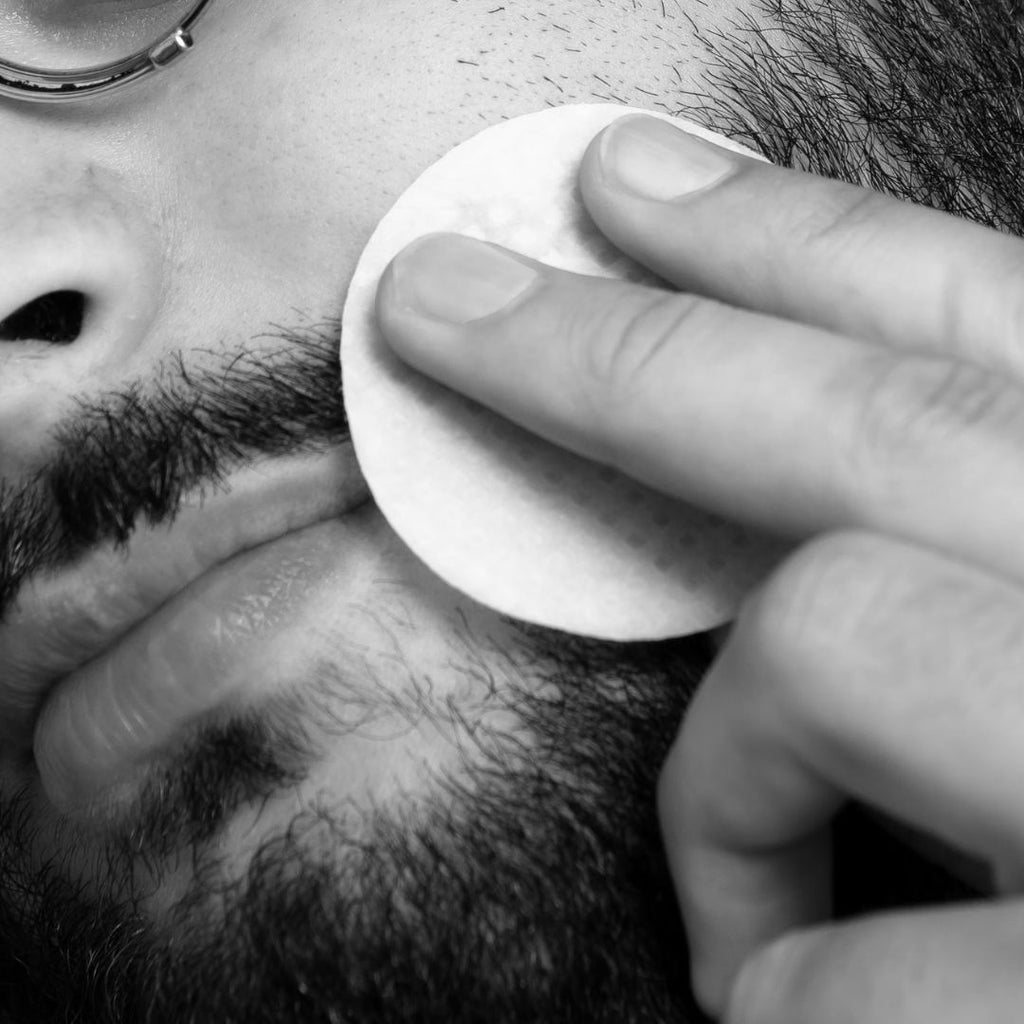Ever looked in the mirror and felt your patchy beard was sabotaging your style? You're not alone. Whether it's genetics, stress, or just plain bad luck, those uneven gaps can be a frustrating roadblock on your beard journey. But don't despair! This guide will provide you with the knowledge and strategies to transform your beard game.
Article at a Glance:
We'll dive into the root causes of patchiness, explore styling tricks to camouflage problem areas, and unveil both simple solutions and advanced techniques. It's time to ditch the patchy beard blues and unlock your beard's full potential.
Understanding the Causes of Patchy Beards

Genetics
Your genes determine the density of hair follicles across your face – some men inherit a layout with closely packed follicles, while others have a naturally sparser distribution.
Your genes also dictate how sensitive these follicles are to growth-promoting hormones, which can vary between different areas of your face.
Additionally, your genetic makeup influences the thickness of your beard hairs and the direction in which they grow, whether it be straight, wavy, or prone to swirling patterns.
All these inherited factors combine to set the baseline potential for your beard's density, fullness, and overall appearance.
Hormonal Fluctuations
While genetics play a major role in determining your beard's potential, hormonal fluctuations can also be the culprit behind patchy growth.
Testosterone, the primary male sex hormone, acts as the fuel for beard growth, but it's not the direct driver.
Testosterone is converted into a more potent form called DHT (dihydrotestosterone), which binds to receptors on hair follicles in your face. Here's where things get interesting – your genetic makeup determines how sensitive these follicles are to DHT.
In some areas, DHT can have the opposite of its intended effect, causing the follicles to shrink and produce thinner, weaker hairs. This miniaturization of follicles can lead to patchy beard growth or a thinner overall beard density.
Skin Issues
Skin issues are significant in beard health and can contribute to patchy growth. Acne, for example, creates an environment of inflammation and irritation around hair follicles. This inflammation can disrupt the normal hair growth cycle, leading to stunted or uneven beard hair.
Similarly, dryness can make beard hair brittle and prone to breakage. The constant scratching that often accompanies dry, itchy skin can further damage hair follicles and hinder healthy facial hair growth.
Other skin conditions like eczema and psoriasis can also impact beard growth. These conditions cause flaky, irritated patches of skin that can impede hair follicle function.
The inflammation and scaling associated with these skin issues can create an unfavorable environment to promote healthy beard growth, leading to patchiness and unevenness.
Therefore, maintaining good skin health is essential for optimizing beard growth potential. If you have underlying skin conditions, seek proper treatment from a dermatologist.
A healthy skincare routine that includes gentle cleansing, moisturizing, and addressing specific skin concerns will create a better foundation for flourishing your beard.
Stress and Lifestyle Factors
Stress Hormone - Cortisol: When you experience chronic stress, your body produces elevated levels of the stress hormone cortisol. Cortisol can negatively impact hair growth in various ways.

- Disrupts hair growth cycle: Cortisol can interfere with the normal phases of hair growth (growing, resting, shedding), leading to more hair follicles entering a resting state prematurely.
- Constricts blood vessels: High-stress levels can cause blood vessels to constrict, reducing blood flow to hair follicles and depriving them of essential nutrients for growth.
- Affects nutrient absorption: High levels of cortisol can hinder your body's ability to absorb the vitamins and minerals necessary for healthy hair.
- Affects skin health: Chronic stress can worsen skin conditions like eczema, psoriasis, and acne, which can cause inflammation and irritation around hair follicles, further hindering healthy beard growth.
Lifestyle Factors That Matter: In the quest for achieving the best beard possible, several of these factors will have a significant impact.

- Poor Diet: A diet lacking in essential nutrients like protein, vitamins (especially B vitamins), and minerals (zinc, iron) can deprive hair follicles of the building blocks needed to grow facial hair.
- Lack of Sleep: When you're sleep-deprived, your body doesn't have adequate time to repair and regenerate. This can slow down hair growth and make it more susceptible to breakage.
- Smoking: Smoking constricts blood vessels and reduces oxygen flow to the skin, including your facial skin, impeding beard growth potential.
- Dehydration: Not drinking enough water can lead to dry skin and hair, making your beard hair brittle and prone to patchy growth.
Styling Your Patchy Beard

Don't let a patchy facial hair hold you back! Own your unique beard style and build your confidence while your beard keeps growing. Let's find ways to work with what you have:
Stubble: Intentionally kept stubble is a great way to camouflage patchiness. It creates a uniform, rugged look without emphasizing any particular areas of thinner growth.
The Goatee: A classic goatee focuses the beard around the chin and mouth, drawing attention away from potentially patchy cheeks or jawline.
Van Dyke: Similar to a goatee, but with a disconnected, styled mustache, the Van Dyke adds another element of interest and can work well with varying growth patterns.

Creative Shapes: If you're feeling adventurous, consider experimenting with other distinct beard shapes. Explore options like the Balbo, chinstrap, or anchor beard that can cleverly disguise unevenness.
Grooming Tips to Enhance Your Look
- Clean Lines: No matter the style you choose, keeping the edges of your beard sharp and well-defined creates a polished, intentional look.
- Camouflaging Patches: With a slightly longer beard, brush the hair in neighboring, denser areas to partially cover patchier spots. This creates an illusion of fullness.
- Play with Color: If you have some grey hairs mixed in, consider a subtle beard dye. Unifying the color can help minimize the appearance of patches.
- Hydration and Care: Use quality beard oil and beard balm to keep your hair hydrated, soft, and more easily managed. Products containing tea tree or peppermint, like our Honor Initiative Defender line, can offer added benefits for skin and follicle health.
Key Takeaway: Own your unique beard and experiment with different styles to find what makes you feel confident and complements your natural growth.
Strategies to Promote Growth

Healthy Lifestyle Choices
While a lot of focus is placed on beard care products and styling techniques for those with patchy beard styles, addressing the root of healthy facial hair growth starts from within. A healthy lifestyle offers several benefits that can contribute to a fuller beard:
Balanced Diet: Ditching junk food, which lacks essential nutrients and can contribute to inflammation, is crucial. Instead, focus on a healthy diet with plenty of fruits, vegetables, whole grains, and lean protein sources to give your facial hair the fuel it needs to reach its full potential.
Regular Exercise: When you work up a sweat, you increase blood circulation throughout your body, including those tiny vessels that nourish your hair follicles. This improved blood flow carries oxygen and vital nutrients directly to the roots of your facial hair, potentially supporting their growth and vitality, leading to fuller facial hair. Aim for at least 30 minutes of moderate-intensity exercise – think brisk walking, jogging, or cycling – most days of the week for optimal benefits.
Adequate Sleep: Adequate sleep acts as a growth accelerator for your beard. During deep sleep, your body releases growth hormones and undergoes essential repair and regeneration processes. This restorative period is critical for healthy cell turnover and can influence hair growth. When you're sleep-deprived, your body can't function optimally, and this can potentially hinder your beard's progress.
Aim for 7-8 hours of quality sleep per night to support beard health and give your follicles the best chance to thrive. Additionally, a consistent sleep schedule helps regulate your body's natural rhythms, further contributing to overall well-being and potentially influencing healthy hair growth.
Beard Care Routine
A healthy lifestyle gives your beard a solid foundation, and a dedicated beard care routine maximizes your results. Here's how to enhance your beard's appearance and support its health:
Gentle Cleansing: Start with a wash specifically formulated for beards. Unlike harsh shampoos, a dedicated beard wash cleanses without stripping your facial hair and skin of essential moisture.
Hydration & Nourishment: Your beard craves hydration! Honor Initiative Beard Oil delivers that with natural oils, along with the potential added benefits of tea tree and peppermint to support skin health and follicle function. For extra conditioning and styling power, follow with Honor Initiative Beard Butter to lock in moisture and tame unruly hairs.
Exfoliation: Two to three times per week, gently exfoliate the skin beneath your beard. This helps remove dead skin cells and stimulates blood flow to hair follicles, creating a healthier environment for growth.
Styling & Patch Management: A beard brush or comb is essential for detangling, distributing beard products evenly, and helping to train your hair to grow in the desired direction. For patchy spots, try brushing surrounding hair to gently camouflage the area. If you do use a beard trimmer, maintain clean lines and shape for a polished look regardless of length.
Consistency is crucial for optimal beard health. Adopt these steps as a regular ritual to support your beard growth goals and enhance your overall beard appearance.
Fix a Patchy Beard: What Really Works?
Microneedling
Microneedling involves using a derma roller or pen-like device fitted with tiny needles to create controlled micro-injuries in the skin. This process triggers the body's natural healing response, potentially increasing blood flow and boosting collagen production.
While primarily used for skincare benefits, this enhanced circulation and collagen stimulation may also benefit dormant hair follicles in your beard area. For optimal safety and effectiveness, it's best to have microneedling performed by a licensed dermatologist or esthetician.
The procedure can cause mild discomfort, and temporary redness or skin sensitivity is common. Results can vary, and it may take multiple sessions over several weeks or months for a noticeable improvement in beard growth.
|
Aspect |
Details |
|
Needle Depth |
0.25mm to 1.5mm for beard growth; shallower is gentler |
|
Frequency |
Sessions spaced 2-6 weeks apart for skin healing |
|
Aftercare |
Avoid harsh products, sun, exercise for 24-48 hrs. |
|
Cost |
$100 to $300+ per session; varies based on provider |
Minoxidil
Minoxidil (commonly known as Rogaine) is a topical treatment originally developed for scalp hair loss. While it has shown some effectiveness in beard growth, how it works for this purpose isn't fully understood.
Potential side effects include skin irritation, dryness, and unwanted hair growth in other areas. It's crucial to note that results can be temporary – you will likely lose any new beard gains if you stop using minoxidil. Consulting with a doctor is recommended before starting this treatment.
|
Aspect |
Details |
|
Strength |
2% or 5% solutions; 5% typically shows faster results. |
|
Application |
Apply twice daily to beard area; wash hands after. |
|
Results |
Noticeable growth may take 3-6 months; varies per person. |
|
Cost |
Can be expensive, especially for long-term use. |
Beard Transplant
A beard transplant surgically relocates hair follicles from a donor area (usually the back of the scalp) to fill in patchy areas of your beard. This is considered a drastic solution when all other strategies have failed to address severe patchiness.
Be aware that it's an expensive procedure, involves a recovery period, and the final results might not look perfectly natural depending on the surgeon's expertise.
|
Aspect |
Details |
|
Density |
Multiple sessions may be needed for desired fullness. |
|
Hairline |
Surgeons must design a natural-looking beard shape. |
|
Scarring |
Tiny extraction scars; surgeon skill minimizes visibility. |
|
Maintenance |
Transplanted hair may need different trimming routine. |
Important Disclaimer: Before pursuing any of these additional options, it's essential to consult with a dermatologist or doctor to determine the potential benefits, risks, and suitability based on your individual situation and beard goals.
Frequently Asked Questions
Q1: Can I really transform a patchy beard into a fuller one?
Absolutely! With the right care, patience, and strategies, it's possible to significantly improve the appearance of a patchy beard, encouraging fuller and healthier growth over time.
Q2: What are the main causes of a patchy beard?
Several factors can contribute to a patchy beard, including genetics, hormonal imbalances, poor nutrition, stress, and inadequate beard care routines.
Q3: How long does it take to see improvements in my beard's fullness?
The time it takes to see noticeable improvements can vary widely among individuals. Consistency is key, and some may start to see changes in as little as a few weeks, while for others, it might take several months.
Q4: What are the best products to use for patchy beards?
Look for products specifically designed to support beard growth, such as those containing natural oils like jojoba, peppermint, and castor oil, as well as vitamins and minerals that nourish the hair and skin.
Q5: Are there any specific foods I should eat to help my beard grow?
Yes, focusing on a balanced diet rich in proteins, vitamins A, B, C, D, E, and minerals like zinc and iron can support hair growth and improve the health of your beard.
Q6: Can exercise impact beard growth?
Indeed, regular exercise increases blood circulation throughout the body, including the face, which can help transport the necessary nutrients to your hair follicles more efficiently.
Q7: How important is hydration for improving a patchy beard?
Very important. Staying well-hydrated is crucial for maintaining healthy skin and hair. It helps to ensure that your beard hair grows in as thick and healthy as possible.
Q8: Are there any grooming tips that can help make a patchy beard look fuller?
Regular trimming, styling, and using beard balms or butters can help shape your beard and make it appear fuller. Additionally, brushing your beard daily can stimulate blood flow and promote a healthier growth pattern.
Q9: What should I do if I'm not seeing any improvement in my patchy beard?
Patience and consistency with your beard care routine are key. If after several months you see no improvement, consider consulting with a dermatologist or a trichologist to explore further options.
Q10: Can stress affect my beard growth?
Yes, high levels of stress can negatively impact your beard's growth and overall health. Finding effective ways to manage stress is an important aspect of encouraging healthier, fuller facial hair.
Final Thoughts
Don't let patchiness dictate your beard potential. Focus on what you can control: healthy habits from the inside out, complemented by a dedicated beard care routine.
These lay the foundation for your best possible beard. If desired, explore additional strategies to address persistent patches.
The key is finding the approach that aligns with your goals and leaves you feeling confident. Take ownership of your beard journey – the possibilities are greater than you might think!
You May Also Like:
10 BEST BEARD OILS FOR BETTER GROWTH AND THICKNESS, ACCORDING TO EXPERTS
Optimize your beard care strategy with our expertly curated list of the 10 best beard oils, designed to promote better growth and thickness. Drawing upon specialist advice in this detailed article, discover the top choices that will help you achieve a denser, healthier beard, ensuring you find the perfect oil to enhance your grooming regimen.
HOW TO TRIM A BEARD: A STEP-BY-STEP GUIDE FOR ALL LENGTHS AND STYLES
Refine your grooming routine with our comprehensive step-by-step guide on how to trim a beard, tailored for all lengths and styles (patchy beards included), derived from expert insights. Master the art of beard trimming and shape your facial hair with precision, ensuring you achieve the perfect look that complements your style and beard type.
TOP 5 BEST BEARD BUTTERS FOR A SOFTER BEARD, ACCORDING TO EXPERTS
Elevate your beard care regimen with our essential guide to the top 5 best beard butters, inspired by expert recommendations. Discover the ultimate selection to nourish and soften your patchy beard, ensuring you select the ideal product for promoting overall beard hair health.





















Leave a comment